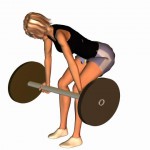 Audience: Runner’s looking to start a simple resistance exercise program who still want most of their time spent running
Audience: Runner’s looking to start a simple resistance exercise program who still want most of their time spent running
Background
You can justify strength training for runners via performance enhancement and injury prevention. Surprisingly, the evidence for performance enhancement is much stronger than injury prevention.
Components of a Good Strength Training Program
You can do thousands of different training programs. Don’t let someone tell you they have the best one or there is one best exercise for you. I recommend that all good programs build comprehensive capacity. Meaning you want a program that trains everything (or close to it)…you don’t want to neglect a movement, a body part or some function (e.g. speed, power, strength) in a year round program. If your program satisfies this simple goal then it is a good program. You might be a fan of pilates, exercise ball training, kettlebell training, TRX, Olympic lifts or Yoga. All of these can help and can be part of your conditioning.
What I am recommending below is just one introductory component of a year round program that you can do for 10-15 minutes before or after your runs.
Why should runners strength train?
Performance Enhancement
We have a great amount of research showing that lower body strength training, power programs, plyometric work and even some simple “core” work can improve mechanical efficiency during running. The reason for this is debatable. It is unlikely that strength training programs that see athletes doing a few sets of 10-15 repetitions translate to improvements in our physiological endurance capabilities. Yet somehow strength and power programs lead to increased efficiency. One theory is that strength training may slightly increase our muscular and connective tissue stiffness or even train the nervous system to modulate such a change. In other words, strength training builds a better spring and running is nothing if not built on good springs. Runners bounce they don’t push.
Don’t worry about becoming muscle bound. This won’t happen. Putting on muscle mass is difficult and and even if you do it won’t lead to a loss of performance
Injury Prevention
This is something we have been recommending for years but in all honesty we actually have little published research linking strength training with decreases in injury rates. Sure, poke around on the internet and you will read about runners with weak glutes, weak hip abductors (I’m guilty of this) and weak hips in general and how these deficiencies are linked with current injuries. The rub is that this is just a link in time (i.e. a correlation) and we actually suck at predicting future injuries. Regardless, it is scientifically plausible that if we can increase the tolerance to tissue loading via strength training in a novel and different manner from how we normally load our tissues (e.g. running) then we might expect some increases in the resiliency of our tissues to the repetitive stresses associated with injury (disclaimer: chronic, persistent pain is a whole other mess). If you are in pain, strength training is a novel movement. This novelty can sneak under our pain radar and modulate the brain’s production of pain and even help resolve a painful running “injury”.
Warning: Runners often train like endurance athletes instead of just athletes. You need to choose exercises that make you tired before 15 repetitions. You need to struggle and you need to push yourself. If you can do 30 squats then you need to either get under a barbell or do one legged squats. You are training strength not endurance. Push yourself goddamnit.
Last Caveat: The exercises that might become easy can then be performed as a warmup or as cooldown.
Alright enough preamble. Below is the program.
6 Exercise Program: All exercises are coupled with another exercise
I use exercises in pairs (couplets) and sometimes in threes (triplets). This called a superset. It is more efficient and decreases the downtime associated with the rest you need between exercises. The exercises that are usually paired train muscles or even sides of the body (front versus back, push versus pull).
When, how much, how often?
- before or after your run
- two to three sets of 10-15 repetitions (if you aren’t tired at 15 reps than you have to find another exercise)
- this can be performed 3 times per week
Couplet One: High Knee Drive to Squat
Standing High Knee Drive
Standing tall drive your knee upwards. Brace through your spine. This exercise can be preceded by a front scale.
Another option is hold your hip flexed (knee above hip) and perform a 6 inch knee lift with the hip already flexed.
Use resistance: add tubing around your knee or perform this on a 4-way hip machine
Thats it. Squat deep. One option is to shift your weight back and forth once you get deep.
You can combine these exercises by squatting, driving up and driving your knee upwards. Then drop back into the squat.
Tip: vary the speed
Tip 2: add weight
Couplet #2: Core Couplet
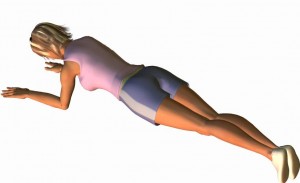 The most popular exercises on the planet. Bridging or planking. Whatever you want to call it.
The most popular exercises on the planet. Bridging or planking. Whatever you want to call it.
These exercises you work your front, your side and even your back.
You can do these exercises separate from one another or you can roll from one hold to the other.
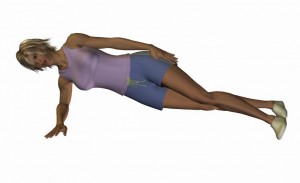 You can hold the positions for 2-3 seconds or go nuts and hold for 30 to 60 seconds. You will get benefit either way. Your goal is to feel tired. When you feel that your form starts to weaken then you can wrap it up.
You can hold the positions for 2-3 seconds or go nuts and hold for 30 to 60 seconds. You will get benefit either way. Your goal is to feel tired. When you feel that your form starts to weaken then you can wrap it up.
Options: lift a leg, rock up and down, roll a little bit
Couplet #3: Single leg squat to lateral birddog (aka birddog hip airplane)
Lateral Birddog Hipairplane: this exercise is a modification of the good old birddog where you lift your leg to the back and your arm to the front. The modification sees you lifting your leg out to the side and then dropping your hip that has the knee on the ground out to the side. You will feel increased pressure in the outside of the hip. Let your other hip drop to the ground and then lift it back up. To really stress things swing other leg side to side.
One leg squat: you can do this with your leg out to the side like in the picture or you can have your leg out back. I recommend hinging forward at your hip and NOT trying to keep your trunk upright. Let it bend forward to increase the strain on your butt.
Go through that circuit. Twice. Its easy, takes 10-15 minutes and is good for us runners who really only want to run but know we should do something else. You can do this one day a week and on two other days make up your own strength couplets. Or just do this 3 times a week but in 4-6 weeks you should mix things up. Add some speed, more weight, different exercises…train variety build capacity.
Related Programs
2. Patellofemoral Pain Rehab Sheets
5. Hamstring Tendinopathy Strength Training Videos: Hint not just for hamstrings



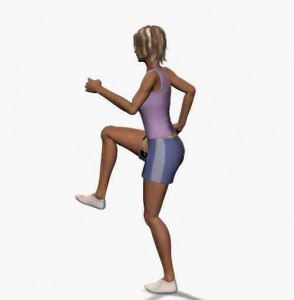
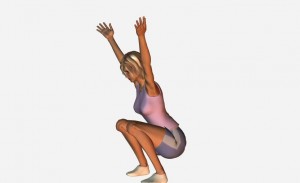
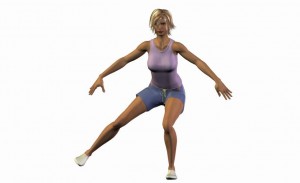
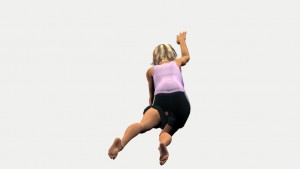
Hi ,
Why do you chose a deep squat over a normal squat?
Why not? . A normal squat is fine. I would not say that the deep squat is “over” the normal squat. Its just one choice in the many that you can make. I like the idea of training through the entire range of motion but I don’t think there is anything wrong with doing a squat where the thighs just become parallel to floor. With depth you may see greater activation of the glut max as well. I wouldn’t put any exercise on a pedestal…if people have trouble with a deep squat then they should only be doing a partial squat. If someone typically trains a body weight deep squat and can do this easily then maybe they should train a partial squat with weight or a one legged partial squat or a lunge or a split squat etc.
. A normal squat is fine. I would not say that the deep squat is “over” the normal squat. Its just one choice in the many that you can make. I like the idea of training through the entire range of motion but I don’t think there is anything wrong with doing a squat where the thighs just become parallel to floor. With depth you may see greater activation of the glut max as well. I wouldn’t put any exercise on a pedestal…if people have trouble with a deep squat then they should only be doing a partial squat. If someone typically trains a body weight deep squat and can do this easily then maybe they should train a partial squat with weight or a one legged partial squat or a lunge or a split squat etc.
well yea , are there not higher compression forces (patello femoral, tibiofemoral) with the deep squat (135-150 degrees). Would a normal squat be “saver” then a deep squat?
cheers
Hi Jeroen,
I have not looked at this stuff in years but I think that if you just model the external forces at the knee you would conclude that there would be more compression at deeper depths of squatting. Now from the best I can recall, if you create detailed biomechanical model of the knee that helps explain how the body reacts to these external forces you find that the compression on the knee cap is not greater because the knee cap will distribute the forces differently as you squat deeper. Thus, the stress per cross sectional area is not any greater. Its like falling. You don’t just fall straight on your feet. You would rather spread the force out over your entire body and do a “break-fall”. Like when stuntmen jump off buildings into cardboard boxes - they land on their backs.